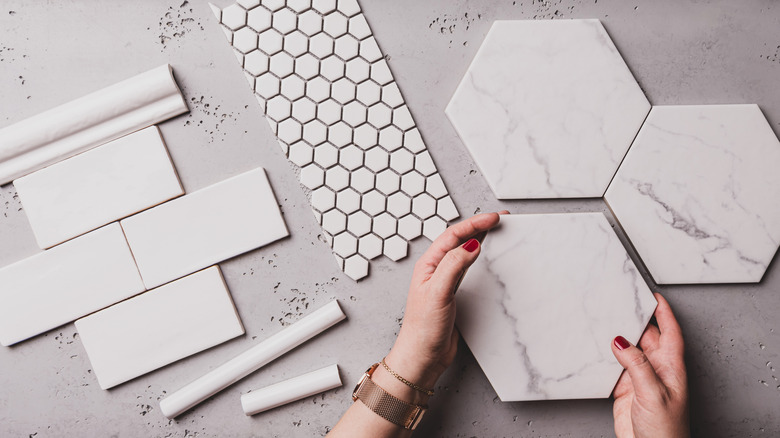Chunky Grout Is The Bathroom Tile Trend That Adds Texture In A Unique Way
Tile is so much more than a tried and true material for showers and bathroom floors — it's a great way to show off your interior design persona and individual style because there are so many ways to personalize a tiling project and truly make it your own. You can select timeless bathroom tile colors and materials, or, you can go bold and daring with a trendsetting look. One tiling trend has less to do with your tile choice and more about how it's installed. Called "chunky grout," this trend encourages homeowners to opt for thick grout lines between tiles. The resultant look provides customization, texture, and an increased visual appeal to your bathroom.
DIY-er @shoemakesnew shared the process of installing her shower tile using vertical tile and wide grout lines along with a six-month update on how well the project was holding up. Sharing her satisfaction with the look and the way it adds natural textural variety to the space, she wrote on Instagram, "I just love this tile and the organic kind of imperfect look of this grout style." Chunky grout lines are a unique way to make a statement with your bathroom renovations. Below, we dive into this tiling trend and discuss the pros and cons, which tile styles are best to use with the chunky grout lines, and things you need to know before you tile.
How to get the chunky grout look
To achieve the chunky grout look, you'll need to select your vertical and horizontal joint size. Joint size is the space between each tile, and your grout will be used to fill these gaps and seal the space between tiles. While the average finished and grouted joint size between tiles usually varies between ¹⁄₁₆ inch to ³⁄₁₆ inch, achieving the chunky grout look requires you to opt for a joint size of around 1 inch, which is the size used by both @shoemakesnew and designer @sarahshermansamuel for their horizontal grout lines. To balance the look, both used slimmer vertical grout lines, which made the chunky horizontal lines pop even more.
Designer @sarahshermansamuel use of chunky horizontal grout lines and thin vertical grout lines for her artisanal farmhouse white brick tiles is perfect for adding that natural texture and interest to your bathroom, while using @shoemakesnew's choice, Cloe by Bedrossian's Tile and Stone, creates a modernized zellige tile inspired look that's more affordable than splurging for the real thing.
Horizontal tiles with thick and thin grout lines aren't the only option. Square tiles with chunky grout lines can create a bold fresh appeal, and horizontal tiles with uniform three-quarter-inch grout lines offer the chunky look with a bit more uniformity and visual cohesion. There's also the option to opt for a vertical or horizontal chunky grout line every few rows of tiles for a truly unique aesthetic.
What to know before you use chunky grout
Chunky grout is an on-trend tile idea that can revamp your space and add personality to your bathroom. But, before you begin, it's important to know that this look isn't ideal for every tile style, and requires certain precautions to ensure its feasibility. For example, for motif tiles, patterned tiles, or tile mosaics, a thinner joint size and less grout may be useful, as thick and chunky grout lines can detract from the overall appearance of your floors or walls and make your patterns and designs appear disjointed.
If you want to use chunky grout for added texture, stick with handmade or textured tiles over rectified tiles, as rectified tiles are very uniform in appearance and typically benefit from smaller grout lines which allow for a smooth flow and sleek look. Rectified and other uniform tiles can be used with chunky grout, but you won't get the natural textured aesthetic, only added visual appeal. Another important factor is choosing the right grout for your tile and joint size. For joint sizes larger than ⅜-inch, heavily sanded grout is necessary over unsanded grout. Although you might be able to make sanded grout by adding coarse sand to regular grout, you should ask your manufacturer if they sell a "wide joint" grout mix to be safe. Also, ask for a quality grout sealer, and seal your grout once it's dried so you can keep the grout moisture-free and prevent deterioration down the road.

